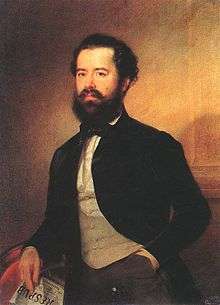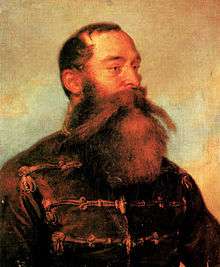Battle of Temesvár
| Battle of Temesvár | |||||||
|---|---|---|---|---|---|---|---|
| Part of the Hungarian Revolution of 1848 | |||||||
 | |||||||
| |||||||
| Belligerents | |||||||
|
|
| ||||||
| Commanders and leaders | |||||||
|
|
| ||||||
| Strength | |||||||
|
55,000 men 120 cannon |
90,000 men 350 cannon | ||||||
| Casualties and losses | |||||||
|
10,490 dead and injured 112 cannon |
4,450 dead and injured 4 cannon | ||||||
The Battle of Temesvár (now Timişoara, in Romania) was a battle in the Hungarian Revolution of 1848, fought on 9 August 1849 between the Austrian Empire and Hungarian Revolutionary Army supplemented by Polish volunteers. The Austrians were led by Julius Jacob von Haynau, while the Hungarians were led by Józef Bem who arrived at the eleventh hour from Transylvania. The Austrians were victorious.
The Hungarians had only their southern division here, and although they had slightly more men than the Austrians, they lacked experience and good equipment. Henryk Dembiński, the leader of this Hungarian division, retreated from Szeged just before the arrival of the army of Julius Jacob von Haynau, where the Hungarians had prepared defence lines. Dembiński was relieved of his command, and Lajos Kossuth asked József Bem to step in.
The Hungarians were stationed at the stronghold of Temesvár (now Timişoara, Romania) when they were attacked from Temesvár Castle too. The Hungarians did well for a while, but when Bem fell from his horse they could not hold the Austrian cavalry.
Pretext
Henryk Dembiński, the originator of the idea to join forces at Szeged, became the supreme commander of the southern Hungarian army, even though Antal Vetter had a chance of getting this post. Dembiński commanded little respect because he retreated in 1831 and it seemed that he couldn't change. He essentially retreated from Szeged and left a legion with only four cannon at Újszeged. He was supreme commander of the Hungarian army at the Battle of Kápolna and the Battle of Szőreg, and lost both.
The Hungarian army left their positions, because they could push the Austrian army, which was crossing Újszeged, towards the River Tisza,[note 1] but it didn't happen. Even though the Hungarians were defending their positions, Haynau crossed the Tisza to Újszeged without resistance. Dembiński stationed his army between Maros and Szőreg and Haynau started to move towards the Hungarian army.

There was a small chance the Hungarian army could win if the Austrian army sent its cavalry against the Hungarian artillery or if Dembiński attacked the Austrian foot. But Dembiński was inactive even though the Hungarian cavalry defeated the Austrian cavalry's attacks and the Hungarian artillery defended their positions too. After the Hungarian army lost the Battle of Szőreg, Prime Minister Bertalan Szemere gave orders to Dembiński to retreat towards Arad (now in Romania) because they wanted him to fight there. That position had many advantages:
- The River Maros (Romanian: Mureş) formed a natural defense line
- The castle of Arad was controlled by the Hungarian revolutionary army
- Other Hungarian legions close by[note 2]
- The Hungarian population was in majority in that area
Dembiński retreated to Temesvár while the Italian legion, under the command of Monti Alessandro, helped the Hungarian army's retreat. The Hungarians were tired and had low morale when they arrived at Temesvár on 9 August. József Bem was at Temesvár when they arrived, and he became the new supreme commander of the Hungarian army.
Battle
Fight for better position

Hungarian plan
The position of the Hungarian army was unfortunate. At Kisbecskerek (now Becicherecu Mic, Romania) there were some cavalry and 4 cannon against the Austrian army. Kmety’s legion’s became the left flank at Szakálháza, on the northern east was Colonel László Gál’s 10th legion, Major-general Richard Guyon with his 4th legion was in the centrum and Major-general Arisztid Dessewffy’s 9th legion was the left flank. Most of the centrum and left flank were stationed in the Csóka and Vadász forests. Vécsey’s 5 th legion surrounded Temesvár. From this legion most of the foot joined in Guyon’s legion because of Bem’s order.
The Hungarian army couldn’t retreat towards Temesvár because the Austrian army was defending the way to the city.
Austrian plan

Haynau didn’t expect any fight on this day and wanted to move his legion to Kisbecskerek. Franz Schlik and his first legion had to advance to Vinga (now in Romania) to block the Arad-Temesvár route. Franz Liechtenstein and his legion had to occupy Hodony and Mercyfalva (now Sânandrei, Romania). Georg Heinrich Ramberg and his 3rd legion had to occupy Kisbecskerek and Szakálháza. Ludwig von Wallmoden-Gimborn and his cavalry had to advance towards Temesvár and Fjodor Szergejevics Panutyin's 9th Russian legion had to occupy Kisbecskerek too.
The fight
The Wallmoden legion bumped into the Hungarian rearguard around 8.30 am. After a short cannon fight the Hungarians had to retreat in the direction of River Nyárád. After a short while the 3rd legion arrived to Kisbecskerek. Haynau with the Russian legion and artillery also arrived Kisbecskerek and ordered his legions to advance towards the Hungarians and attack them.

After that Haynau saw the Hungarians army was advancing towards his legion, he gave the order to attack the Hungarians: he sent 12 cannon. Bem ordered six cavalry troops and one cannon to attack Haynau. It was successful and the Austrians had to retreat. Furthermore, Haynau’s legion mixed up the advancing Russian army. Haynau attacked back with fourteen cavalry troops and sent an order to Liechtenstein that he had to advance to Szentandrás (now Sânandrei, in Romania) and attack the right Hungarian flank.
Bem’s artillery was too enthusiastic and used up their munitions quickly. When he sent for more munitions, Bem did not know that Dembiński moved the spare munitions to Lugos (now Lugoj, Romania), so Bem gave the order to Kmety to move forward on the left flank. Kmety sent his cavalry against the Austrians but they defended themselves. Another Hungarian troop surrounded the Austrians and made them to retreat.

At this time there were 120 Hungarian cannon and 108 Austrian canon. The great cannon fight stopped immediately after a while because the Hungarians didn’t have more munitions. Haynau realized this and ordered the Austrians to move forward in the hope that Liechtenstein’s reinforcement would arrive soon. This happened around 5 pm but it was not the same how Haynau had imagined because Liechtenstein’s army was divided and arrived from two directions. Liechtenstein’s army started attack the Hungarians from the front and the side. The Hungarian army had to retreat in the direction of the River Nyárád. General Mór Perczel tried to help to the Hungarians and sent his 9th legion to Újbesenyő (now Dudeştii Noi, Romania). But because no one wanted to command this legion they also retreated to Nyárád.
Unfavourable turn

Bem ordered Kmety to advance while he went to the right flank. But he fell off his horse and got injured and it meant that there were no one who could conduct the whole Hungarian army.
Dessewffy tried to stop Liechtenstein with his troops and 3 cannon, but the Austrian army was stronger and the 4th and 9th legions started to retreat. Dessewffy had to retreat too, to avoid the Austrian army cutting him off. The Austrian army pursued the Hungarians.
Retreat

Perczel then arrived at the Hungarian rearguard to attack the pursuing Austrian army. They started to fire at the Austrian army, who returned fire more strongly, and the Hungarians started to panic. There were about 30,000 men who said they would desert after the first gunshot. The 9th Hungarian legion shrank from 16,000 men to 7,000. Haynau captured about 6,000 to 7,000 men, the largest number of captives since the Winter Campaign.
Aftermath
There was no longer any chance the Hungarians could win the revolution, and after the defeat it became obvious that the Hungarians could gain no advantage from their capitulation. Every other Hungarian attempt to win a battle was unsuccessful.
The battle was the last major one in the Hungarian Revolution. During the retreat the Hungarian army broke up and just only half of it arrived at Lugos. Haynau left Temesvár. After the battle it was impossible to continue the revolution and the Hungarians formally declared their surrender at Világos (now Şiria, Romania).
Notes
- ↑ Vilmos Lázár was begging Dembiński to make this move.
- ↑ mainly Görgei's Upper-Danube legion and other legions too, except Károly Vécsey's 5th legion and György Kmety's legion. Because the 5th legion was attacking Temesvár, they couldn't move forces from there to help.
Sources
- Herman, Róbert (2004). Az 1848–1849-es szabadságharc nagy csatái ("Great battles of the Hungarian Revolution of 1848-1849") (in Hungarian). Budapest: Zrínyi. ISBN 963-327-367-6.
- Az 1848–1849-es szabadságharc története ("The history of the Hungarian Revolution of 1848-1849) (in Hungarian). Budapest. ISBN 963-8218-20-7.
- Herman, Róbert. Az 1848–1849-es szabadságharc hadtörténete ("Military History of the Hungarian Revolution of 1848-1849") (in Hungarian). ISBN 963-9376-21-3.
External links
| Wikimedia Commons has media related to Battle of Temeswar. |
- "A Temesvári csata rövid összefoglalója ("Short summary of the Battle of Temesvár")" (in Hungarian). Retrieved 16 December 2009.
- "A Temesvári csata a Sulineten ("The Battle of Temesvár on the Sulinet webpage ")" (in Hungarian). Archived from the original on 17 June 2011. Retrieved 16 December 2009.